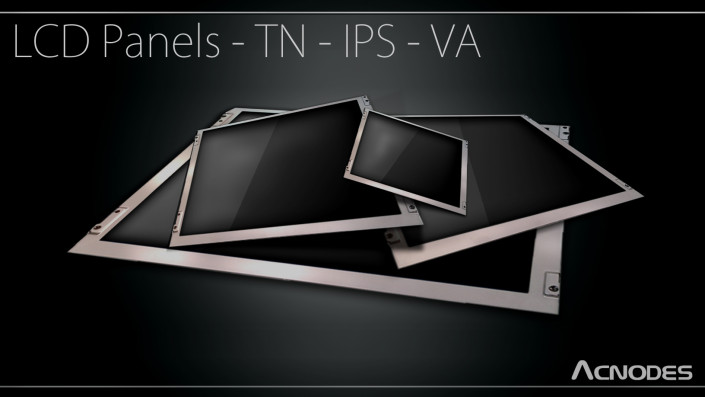Buying Guide: A Few Basic Things You Need To Look For When Choosing an LCD Monitor
Basic characteristics of LCD monitor:
Brightness:
When looking for a good LCD, make sure brightness is above 200 NITS. The higher the brightness levels the higher the picture quality. These units are also measured in luminance (cd/m2), or candelas per square meter. For High brightness, the LCD monitor should have at least 800 NITS or above.
Contrast Ratio:
This is defined by luminance of the brightest white color in relation to the darkest black color. The higher the contrast ratio, the more vivid the picture can be. There are considerable differences in the ratio. Low is anything below 100:1. You would want to select a contrast ratio of 350:1 or higher.
Wide viewing ranges:
Wide viewing range simply put, refers to a range of angles which a display can still be viewed with minimal or no loss of performance. The larger a viewing area, the more relaxed and natural the image is. The viewing angle comes into play when there is a slight change in viewing position. Once the angle changes, depending on the monitor, you might not be able to determine what is on the screen or the pictures become fuzzy or hazy. The viewing angle is calculated with an algorithm that incorporates the visible range from the middle of the screen to the top and bottom corners of the screen. The higher the value, the more natural the picture becomes and in turn gives you a wider range in viewing angles. The range of the four directions although, are not necessarily symmetrical. When measuring up and down angles, some manufacturers will label it Horizontal and Vertical.
Signal response time:
Signal response refers to the time elapsed when the computer receives a keyboard or mouse command and displays it on the monitor. The Signal response of the animation and mouse movement is very important. This phenomenon generally occurs only with LCD monitors. CRT monitor however, do not have this problem. The faster response time correlates to a more natural movement. The slower response time of course would be choppy making mouse movement’s jump from one place to another rather than a stream line move. In the general sense of the word, low-end LCD monitor displays have input signals disappear when used with a fast-moving signal. Unlike high end LCD monitor displays, which have a more natural and streamlined display and accommodate faster response times.
Difference between LED and CCFL backlight:
1. Backlight source:
CCFL backlight (cold cathode fluorescent lamp). It uses alternating current for its luminance and is used widely on LCD’s because of it inexpensiveness.
LED Backlight (light emitting diode), Brightness on this backlight is adjusted according to the image which makes the display output brighter and have a more vivid picture. These backlights are composed of many grid-like LED’s.
2. Space and weight:
The use of the LED backlight on LCD panels reduces overall weight and thickness. Unlike the CCFL backlight, which are more bulky and are heavier.
3. Voltage and Power consumption:
LED backlight uses a low-voltage DC power source. This increases efficiency and consumes on average about 10 watts or less.
CCFL backlights use a high-voltage AC source which reaches 1500 - 1600Vac and stabilizes at 7,800 VAC. Each CCFL lamp consumes about 10 watts, a 20-inch monitor for example requires at least six lamps which when calculated consumes around 60 watts. This backlight method also requires a power inverter.
4. Lifetime:
In terms of luminescence lifetime, LED backlight technology can go beyond more traditional LCD screen and have over 100,000 hours or 10+ years before failure.
The life of an ordinary LCD with the CCFL backlight is generally around 30,000 to 60,000 hours or 6 to 7 years.
5. Environmental:
Mercury is the main ingredient of CCFL lighting lamp, and LED is Mercury free.
Types of LCD panels:
LCD panels can be categorized with their response time, color, viewing angle, contrast, and brightness.
In the current market, 70% of the LCD monitors price is based on the Liquid crystal panels it uses. The other 30% is based on the drive circuits and it housing or overall aesthetic appearance. These LCD panels are broken down into three different types:
1. TN Panels
2. IPS Panels
3. VA Panels
TN panel (Twisted Nematic):
(TN) Twisted Nematic is a liquid crystal molecule that are twisted to produce light and dark contrast. When voltage is applied to these particular molecules it behaves in such a way where the liquid crystal molecules closest to the upper and lower boundaries of the glass substrate do not move while the middle portion of the liquid crystal molecules tilt down, so that the angle of the light penetration in each molecule varies when viewed from certain angles. One angle will be bright, while another angle will be dim. These Panels are usually soft to the touch and produces a somewhat of a waterline or wave patterns.
TN panels deflect the liquid crystal molecules very quickly thus improving the response time. This however affects its color performance when compared to the IPS or VA type LCD panels.
IPS Panel (In-plane Switching):
The IPS panel use a technique that arranges the direction of the liquid crystal molecule into parallel with its glass substrate. Once voltage is applied to the liquid crystal molecules it rotates and maintains a horizontal position. No matter which angle, the images he or she sees will not be distorted.
IPS panel provides wide viewing angles, fast response (compared to the VA panel display) and accurate color reproduction. It also has a harder surface coating than any other type of LCD. It will not produce any water lines or waves when the bare surface is touched. The disadvantages of the IPS panel however, is that it leaks over time and its black color is not pure enough that is needs to rely on an optical compensation film to achieve a better quality.
VA (Vertical Alignment) panel:
When no voltage is applied, the liquid crystal molecules are arranged perpendicular to the glass base. The light through the liquid crystal molecules are blocked by the Polaroid molecules and shows an all-black state. The liquid crystal molecules once voltage is applied will tilt down, allowing light to pass through. These perspectives however were too narrow and caused a serious problem. This is why the MVA (Multi-domain Vertical Alignment) technology was adapted to rectify this problem.
The VA panel provides more display viewing angle, high contrast performance and accurate color reproduction. The disadvantages of the VA panel though is its high power consumption, and its low response time.
These panels also have a soft coating surface so when touched it produce a plum pattern on the screen.
Conclusion:
It should be emphasized that liquid crystal display panels are just one of the important components, drive circuit, backlight module are also a factor in the final image. There are various manufacturers with the same panel that produce totally different visual effects. When sourcing for an LCD panel, you need to understand the basic characteristics of the monitor. You need to choose based on what your needs are. For example, most professional artists use liquid crystal display in the IPS Panel form factor. This is because it is the best panel that can reproduce color, but this choice is very costly. If you just need a good monitor to do office work and such, the TN panel should suffice.





